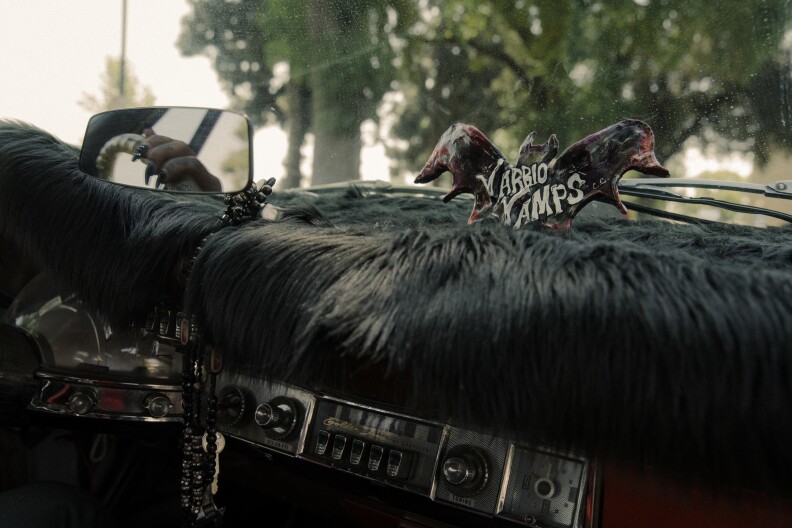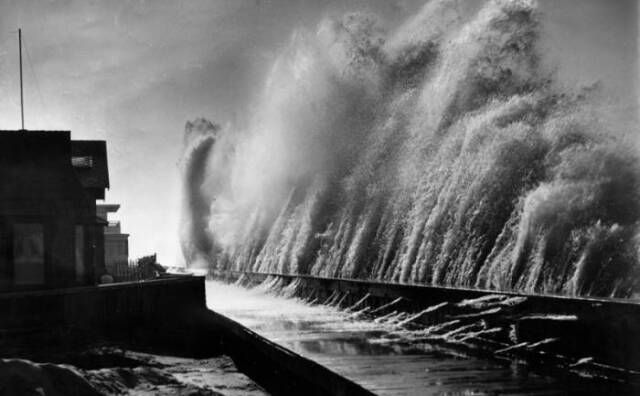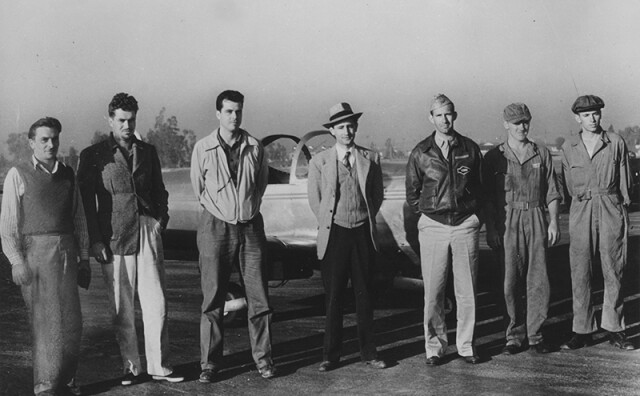The metal flakes painted onto Sandy Avila’s car glisten as she reaches under her chromed-out dashboard, flicks a switch skyward then back down — click, click — and the front end of her '84 Oldsmobile Cutlass Supreme starts to bounce.
Satisfaction spreads across Avila’s face. Since purchasing the car in 2018, she’s redone the suspension and engine, had it painted and reinforced, added hydraulics and chrome, and fixed up the interior. It's now a glistening cream color with beige pinstripes, whitewall tires and vinyl seats.
Customizing her car, which she’s named Simply Beautiful, is an expensive, all-consuming labor of love. But Avila doesn't do it alone; she's the president of Lady Lowriders Car Club, a six-member Pasadena-based group she co-founded in 2021.
“It's a lot of work,” she said. “Like they say, it's not a hobby, it’s a lifestyle. You have to have that thing, where you do this because you love it.”
Women who love cars haven’t always had a place in custom car culture, which has deep roots in Los Angeles. Historically, car clubs — groups that unite car aficionados who pour time, money and endless love into customizing their vehicles — have been all-male, with wives and girlfriends relegated to the passenger seat or organizing events behind the scenes.
It's not a hobby, it’s a lifestyle.
But recently, all-female car clubs have been popping up throughout Southern California. The Black Widows Car Club, formed in 2000, was the first L.A.-based all-female club to form since the 1970s. Fifteen years later, Las Chingonas Car Club was founded, and then, in rapid succession, Varrio Vamps Car Club, Avila’s Lady Lowriders, and Latin Queens Inland Empire. Further north saw the formation of the Sunnyvale-based Dueñas Car Club.
Avila attributes the phenomenon in part to social media.
“Before last year, I had never really heard of an all-women's car club,” she said. “But then, when me and my girl decided to start one, I started looking and I started seeing a couple; a couple here, a couple there. And I was like, so they do exist.”
Denise Sandoval, a professor of Chicana/o Studies at Cal State Northridge, agrees. Sandoval has researched and participated in lowriding culture for over 20 years. She said that, recently, the conversation around women’s participation in historically male endeavors has expanded to include activities outside academia and the traditional women’s movement.
“We're in this sort of new age of women empowerment, right, and feminism,” she said. “It's much more about pop culture giving us these images of what a strong woman is.”
Newly-established all-female car clubs have style and swagger, with members often sporting tattoo sleeves, impeccable makeup and hair, and a unified sartorial statement; a devotion to aesthetics that extends to their vehicles. They also have deep knowledge about automobiles, and demand to be taken as seriously as their male counterparts.
“I've been so inspired and so excited by what I've been seeing in these last five years,” said Sandoval. “Women, we've always been a part of lowriding, but you never saw women sort of maintaining these lifelong relationships with their cars. But we're seeing it now: the birth of all-girl car clubs. Women are becoming the next chapter.”
Tending A Community
The practice of customizing cars has been around for as long as cars themselves; in the automobile's earliest days, it was the domain of the very wealthy. Then, in the 1920s, a small subculture of American car enthusiasts began altering vehicles’ engines and frames to maximize their potential for speed; the cars became known as hot rods. As soldiers returned from World War II with engineering knowledge and steady paychecks to fund a hobby, the practice gained popularity.
Customized cars caught on in L.A. as well, but with a twist; in predominantly Mexican American neighborhoods like East L.A. and Boyle Heights, a desire emerged to create a unique vehicular aesthetic and identity separate from white culture. Instead of gunning for speed, drivers began lowering their vehicles’ frames until they were just inches from the ground, then cruising around the neighborhood. The practice earned the moniker “low and slow,” and the culture became known as lowriding.
Steve Velasquez, a curator at the Smithsonian's National Museum of American History, said the tradition quickly became a part of L.A.’s Mexican American culture, serving to solidify an identity among folks with shared backgrounds.
“Low and slow is almost a political movement,” he said. "It was about community. You want to gather your community, and if you're going fast, you kind of lose those roots and those connections. But if you're slow and deliberate, you're tending these roots, and you're tending a community.”
Custom car aesthetics evolved organically. Halfway through the 20th century, L.A.-based artists like George Barris and Larry Watson pioneered body customizations as well as paint styles like pinstriping, flakes and candy colors; the late 1950’s saw the introduction of hydraulics to make cars lift, lower and bounce. Master painters like Mario Gomez perfected their styles. From there, imaginations — and a healthy dose of one-upmanship — took off.

“Cars are in conversation with each other, and [it’s] a competitive world,” said Sandoval. “So if one person does this, how can I take what that person did and step it up to the next level, right? That's how the car custom culture has sort of developed.”
When the civil rights and Chicano movements took hold in the 1960’s and 1970’s, cars became canvasses to express cultural pride as much as clothing and protest signs. Artists began painting murals of Mexican saints, Spanish phrases and religious figures on vehicles' paneling, and the bold, bright colors of custom cars became a way for Mexican American communities, which were politically underrepresented and marginalized, to be seen and honor their roots.
Sandoval recalls a favorite saying of the late Julio Ruelas, a co-founder of Duke’s Car Club, the oldest and longest-running car club in L.A. and possibly the world.
“He would always say that Chicanos, we got our colors from the Aztecs,” she said. “And the feathers, right? You look at the Aztec culture, and all their use of colors, all the bright colors — that's our history.”
From Passenger To Driver
During the mid- to late-20th century, a handful of women became involved in car culture. One of the best-known all-female car clubs was the Lady Bugs Car Club, founded in the early 1970’s in and around L.A. All members owned Volkswagen Beetles, and the group rose to prominence until disbanding at the end of the decade.
But for the most part, car culture was a man’s world. Club members’ wives and girlfriends operated behind the scenes doing planning and secretarial work. Many clubs became pillars in their communities, organizing toy drives or food drop-offs; women frequently did the unseen labor to get those events off the ground.
Gloria Ruelas remembers those days vividly. In 1974, Ruelas married Fernando Ruelas, Julio’s brother and another co-founder of Duke’s. Gloria became the club’s secretary, treasurer and default events planner.
“[Fernando] needed help with getting the roster going, keeping track of who's paying dues, and the events and things like that,” she said. “I kind of fell into it from the start.”
Responsible for coordinating functions as well as communication between Duke’s many — and eventually, far-flung — chapters, Gloria did work for the club every day at the height of its activity. She recruited additional women as well, reaching out to her sisters-in-law and other club wives.
“It was like another job,” she said. “My day [was] to get the kids to school and do what I had to do concerning club functions, and then get back to the family life … It wasn't easy, because we didn't have computers or cell phones or emails or any of that going. That's a totally different time.”
This, she said, was how it was for most women in car culture.
“There were a few [women] that had their own cars then, but not very many,” she said. “The roles were the same as my roles. You were kind of like, on the sidelines.”
The lowrider culture is not only dependent on the bodies of cars, but also on the bodies of women. It's sort of like this marriage of objects.
The accepted notion of women as necessary but sidelined ran deep in custom car culture, said Sandoval, and is even reflected in some of its more ubiquitous artwork. In addition to candy colors and pinstriping, religious figures and catchphrases, many custom vehicles boast murals of seductive-looking women. As the decades wore on, it became common practice to pose women in revealing clothing next to cars, either at shows or in photographs.
“The lowrider culture is not only dependent on the bodies of cars, but also on the bodies of women,” said Sandoval. “It's sort of like this marriage of objects.”
The recent rise, then, of all-female car clubs does more than put women in the driver’s seat. It shifts them from accessory to main character, demanding an end to oppressive, limiting stereotypes and a way to take ownership of identity — just as lowrider culture originally set out to do.
Ruelas, for one, is ready. Her family has a '53 Chevy that’s been waiting for repairs — “you know, you set things aside,” she said — and when it’s complete, it will be hers.
“There's a lot more women that have their own cars,” she said. “It’s great. I can't wait to have my truck done so I can join them.”

‘It’s How I Express Myself’
Julie Maldonado, who goes by Latina Vamp or LV, and Lillian Romero, who goes by Lily Monzter, have been at Pico Park for less than five minutes when a passing driver slows to a crawl. Rolling down her window, the driver hollers, “I love your cars!”
The cars in question, a '62 Chrysler 300 and a '56 Lincoln Premiere, are hard not to love. Both are painted jet black and pristinely maintained, with colorful pinstripes lining the panels. LV’s Chrysler, named Santa Muerte after the Mexican saint of death, sports a glossy finish and an homage to the vehicle’s namesake on the trunk, four red roses by her head, hands in prayer position. Monzter’s Lincoln is finished in matte; purple paint with metal flakes encases the roof, and a rendering of Lily Munster (played on the CBS television sitcom The Munsters by actress Yvonne De Carlo) adorns the trunk.
The two women are co-founders of Varrio Vamps Car Club, whose members drive classic cars. Unlike lowriders, classic cars do not incorporate hydraulics, and custom modifications tend to hew closer to the look of the original vehicle.

Varrio Vamps' vibe is more goth than glam. Heavily tattooed and with striking looks and style — LV calls herself a “rocka-Chola,” part rockabilly and part Chola — both LV and Monzter grew up around custom cars in L.A., with friends or family members involved in the scene. Like Avila, both view their cars as part of a lifestyle.
“It’s just how I've always lived, how I express myself,” said Monzter.
Men who belong to car clubs are often required to attend events. That could mean weekends away from their families, or full days spent working on their cars. For all-female car clubs, things look different.
“We always tell the girls, your family’s first,” said Monzter. “So it's like, if we have a show, it'd be nice if we can all go, but if you have a family thing or something, we get it. We're women, we have life outside from, you know, doing this stuff. That always takes precedence.”
“Women have so much on their plates when it comes to raising children,” said Avila. “It's hard to throw another priority on the table … I can do it because my kids are older. I’m not stuck at home. I feel like that's why you don't see too many younger women; it's a big commitment. It really is.”

For those who can commit, though, whether once a week or once a month, car clubs are a way to find shared community and chosen family. Since women are still relatively rare in the scene, those who participate often develop profound bonds and understanding they may not find elsewhere.
Monzter describes becoming estranged from her mother at the age of 13, when she decided to shave her head and join the punk scene. “She was embarrassed,” she said. “She didn’t want nothing to do with it.”
LV, who has a close relationship with her family, still describes herself as “the black sheep.”
“My family is very traditional,” she said. “I grew up with a strict upbringing from my dad … the hardest thing for me to do was show my dad I had tattoos.”
When LV and Monzter met, they felt an immediate connection. “We got along so well, because we're like, we're witches, right?” said LV, laughing. “Like, we're sisters, we have lots in common, we have the same interests.”
Avila found a similar sense of belonging. The first time she went to a car show with her husband and saw a woman driving her own lowrider, something clicked.
“She was, you know, doing her hydraulics, hitting her switches,” she said. “And I was like, wow, that is so cool. Because mind you, the stereotype was that that doesn't exist. I'm saying, I had never seen a woman have a lowrider, let alone operate it. The people out there were telling me that she fixes her parts, she works on it herself. And I was just like, yes. I want to do that.”
Like LV and Monzter, Avila often felt like an outsider because of her passion for cars.
“I would always be like, I'm such a weirdo, you know what I mean?” she said. “Like, it was not normal for a girl to look at a car. What female does that? I was like, a little embarrassed.”
That embarrassment has shifted completely. Avila now cruises everywhere, from her kids’ schools to car shows, in Simply Beautiful. She’s won awards for the vehicle; now, she's the woman posting inspiring images to Instagram. Parents message her to tell her she’s encouraging their daughters; one prospective member of Lady Lowriders is 16 years old.

Avila feels keenly the responsibility to pay inspiration forward.
“What really humbles me and keeps me going is when I see all these younger ladies, and even older women that have been riding for years but have always been in the passenger side,” said Avila. “They've told me, ‘I would have loved to have a car, but I don't because it's a man thing. But I see you out there, and I'm getting a car.’”
LV feels the same. Having her own custom car parked in her driveway, a vehicle she designed and built that doesn’t belong to a husband, father, brother or other man is, she said, “a sense of independence and feeling accomplished” — one she hopes to pass on.
“I want people to be able to see a woman driving a car like that and say, yeah, you could have that,” she said. “You could do anything you want.”
-
Restored with care, the 120-year-old movie theater is now ready for its closeup.
-
Councilmember Traci Park, who introduced the motion, said if the council failed to act on Friday, the home could be lost as early as the afternoon.
-
Hurricane Hilary is poised to dump several inches of rain on L.A. this weekend. It could also go down in history as the first tropical storm to make landfall here since 1939.
-
Shop owners got 30-day notices to vacate this week but said the new owners reached out to extend that another 30 days. This comes after its weekly swap meet permanently shut down earlier this month.
-
A local history about the extraordinary lives of a generation of female daredevils.
-
LAist's new podcast LA Made: Blood Sweat & Rockets explores the history of Pasadena's Jet Propulsion Lab, co-founder Jack Parsons' interest in the occult and the creepy local lore of Devil's Gate Dam.














